Development of Highly Sensitive Strain Sensor Using Area-Arrayed Graphene Nanoribbons
Abstract
:1. Introduction
2. Fabrication of Area-Aligned Graphene Nanoribbons
3. Results and Discussion
3.1. Evaluation of the Quality of Fabricated Graphene Nanoribbons
3.2. Electronic Characteristics of Fabricated Graphene Nanoribbons
3.3. Evaluation of the Strain Sensitivity of the Fabricated Graphene Nanoribbons
4. Conclusions
Author Contributions
Funding
Institutional Review Board Statement
Informed Consent Statement
Data Availability Statement
Conflicts of Interest
References
- Yamada, T.; Hayamizu, Y.; Yamamoto, Y.; Yomogida, Y.; Izadi-Najafabadi, A.; Futaba, D.N.; Hata, K. A stretchable carbon nanotube strain sensor for human-motion detection. Nat. Nanotechnol. 2011, 6, 296–301. [Google Scholar] [CrossRef] [PubMed]
- Ryu, S.; Lee, P.; Chou, J.B.; Xu, R.; Zhao, R.; Hart, A.J.; Kim, S.G. Extremely elastic wearable carbon nanotube fiber strain sensor for monitoring of human motion. ACS Nano 2015, 9, 5929–5936. [Google Scholar] [CrossRef]
- Li, X.; Zhang, R.; Yu, W.; Wang, K.; Wei, J.; Wu, D.; Cao, A.; Li, Z.; Cheng, Y.; Zheng, Q.; et al. Stretchable and highly sensitive graphene-on-polymer strain sensors. Sci. Rep. 2012, 2, 870. [Google Scholar] [CrossRef] [PubMed] [Green Version]
- Tian, H.; Shu, Y.; Cui, Y.L.; Mi, W.T.; Yang, Y.; Xie, D.; Ren, T.L. Scalable fabrication of high-performance and flexible graphene strain sensors. Nanoscale 2014, 6, 699–705. [Google Scholar] [CrossRef]
- Yan, C.; Wang, J.; Kang, W.; Cui, M.; Wang, X.; Foo, C.Y.; Chee, K.J.; Lee, P.S. Highly stretchable piezoresistive graphene–nanocellulose nanopaper for strain sensors. Adv. Mater. 2014, 26, 2022–2027. [Google Scholar] [CrossRef]
- Yang, H.; Yao, X.; Zheng, Z.; Gong, L.; Yuan, L.; Yuan, Y.; Liu, Y. Highly sensitive and stretchable graphene-silicone rubber composites for strain sensing. Compos. Sci. Technol. 2018, 167, 371–378. [Google Scholar] [CrossRef]
- Lee, C.; Wei, X.; Kysar, J.W.; Hone, J. Measurement of the elastic properties and intrinsic strength of monolayer graphene. Science 2008, 321, 385–388. [Google Scholar] [CrossRef]
- Pereira, V.M.; Neto, A.C.; Peres, N.M.R. Tight-binding approach to uniaxial strain in graphene. Phys. Rev. B 2009, 80, 045401. [Google Scholar] [CrossRef] [Green Version]
- Kim, K.S.; Zhao, Y.; Jang, H.; Lee, S.Y.; Kim, J.M.; Kim, K.S.; Ahn, J.H.; Kim, P.; Choi, J.Y.; Hong, B.H. Large-scale pattern growth of graphene films for stretchable transparent electrodes. Nature 2009, 457, 706–710. [Google Scholar] [CrossRef] [PubMed]
- Chen, J.H.; Jang, C.; Xiao, S.; Ishigami, M.; Fuhrer, M.S. Intrinsic and extrinsic performance limits of graphene devices on SiO2. Nat. Nanotechnol. 2008, 3, 206–209. [Google Scholar] [CrossRef]
- Nakada, K.; Fujita, M.; Dresselhaus, G.; Dresselhaus, M.S. Edge state in graphene ribbons: Nanometer size effect and edge shape dependence. Phys. Rev. B 1996, 54, 17954. [Google Scholar] [CrossRef] [Green Version]
- Son, Y.W.; Cohen, M.L.; Louie, S.G. Half-metallic graphene nanoribbons. Nature 2006, 444, 347–349. [Google Scholar] [CrossRef] [Green Version]
- Son, Y.W.; Cohen, M.L.; Louie, S.G. Energy gaps in graphene nanoribbons. Phys. Rev. Lett. 2006, 97, 216803. [Google Scholar] [CrossRef] [PubMed] [Green Version]
- Lu, Y.; Guo, J. Band gap of strained graphene nanoribbons. Nano Res. 2010, 3, 189–199. [Google Scholar] [CrossRef] [Green Version]
- Wakabayashi, K.; Takane, Y.; Yamamoto, M.; Sigrist, M. Electronic transport properties of graphene nanoribbons. New J. Phys. 2009, 11, 095016. [Google Scholar] [CrossRef] [Green Version]
- Yang, M.; Ohnishi, M.; Suzuki, K.; Miura, H. Effect of Three Dimensional Strain on the Electronic Properties of Graphene Nanoribbons. In Proceedings of the ASME 2015 International Technical Conference and Exhibition on Packaging and Integration of Electronic and Photonic Microsystems Collocated with the ASME 2015 13th International Conference on Nanochannels, Microchannels, and Minichannels, San Francisco, CA, USA, 6–9 July 2015. [Google Scholar] [CrossRef]
- Cai, J.; Pignedoli, C.A.; Talirz, L.; Ruffieux, P.; Söde, H.; Liang, L.; Fasel, R. Graphene nanoribbon heterojunctions. Nat. Nanotechnol. 2014, 9, 896. [Google Scholar] [CrossRef] [PubMed] [Green Version]
- Llinas, J.P.; Fairbrother, A.; Barin, G.B.; Shi, W.; Lee, K.; Wu, S.; Bokor, J. Short-channel field-effect transistors with 9-atom and 13-atom wide graphene nanoribbons. Nat. Commun. 2017, 8, 1–6. [Google Scholar] [CrossRef] [Green Version]
- Yamaguchi, J.; Hayashi, H.; Jippo, H.; Shiotari, A.; Ohtomo, M.; Sakakura, M.; Sato, S. Small bandgap in atomically precise 17-atom-wide armchair-edged graphene nanoribbons. Commun. Mater. 2020, 1, 1–9. [Google Scholar] [CrossRef]
- Sasaki, S.; Yang, M.; Suzuki, K.; Miura, H. Highly-sensitive graphene nano-ribbon-base strain sensor. In Proceedings of the ASME 2016 International Mechanical Engineering Congress and Exposition, Phoenix, AZ, USA, 11–17 November 2016. [Google Scholar] [CrossRef]
- Nakagawa, R.; Wang, Z.; Suzuki, K. Area-arrayed graphene nano-ribbon-base strain sensor. In Proceedings of the ASME 2018 International Mechanical Engineering Congress and Exposition, Pittsburgh, PA, USA, 9–15 November 2018. [Google Scholar] [CrossRef]
- Goundar, J.A.; Kudo, T.; Zhang, Q.; Suzuki, K.; Miura, H. Strain and Photovoltaic Sensitivities of Dumbbell-Shape GNR-Base Sensors. In Proceedings of the ASME 2019 International Mechanical Engineering Congress and Exposition, Salt Lake City, UT, USA, 11–14 November 2019; Volume 59476, p. V010T12A016. [Google Scholar] [CrossRef]
- Yang, M.; Sasaki, S.; Ohnishi, M.; Suzuki, K.; Miura, H. Electronic properties and strain sensitivity of CVD-grown graphene with acetylene. Jpn. J. Appl. Phys. 2016, 55, 04EP05. [Google Scholar] [CrossRef]
- Zhang, W.; Wu, P.; Li, Z.; Yang, J. First-principles thermodynamics of graphene growth on Cu surfaces. J. Phys. Chem. C 2011, 115, 17782–17787. [Google Scholar] [CrossRef] [Green Version]
- Yang, M.; Sasaki, S.; Suzuki, K.; Miura, H. Control of the nucleation and quality of graphene grown by low-pressure chemical vapor deposition with acetylene. Appl. Surf. Sci. 2016, 366, 219–226. [Google Scholar] [CrossRef]
- Li, X.; Magnuson, C.W.; Venugopal, A.; Tromp, R.M.; Hannon, J.B.; Vogel, E.M.; Ruoff, R.S. Large-area graphene single crystals grown by low-pressure chemical vapor deposition of methane on copper. J. Am. Chem. Soc. 2011, 133, 2816–2819. [Google Scholar] [CrossRef] [PubMed]
- Li, X.; Zhu, Y.; Cai, W.; Borysiak, M.; Han, B.; Chen, D.; Ruoff, R.S. Transfer of large-area graphene films for high-performance transparent conductive electrodes. Nano Lett. 2009, 9, 4359–4363. [Google Scholar] [CrossRef] [PubMed]
- Yang, H.; Jin, A.; Luo, Q.; Li, J.; Gu, C.; Cui, Z. Electron beam lithography of HSQ/PMMA bilayer resists for negative tone lift-off process. Microelectron. Eng. 2008, 85, 814–817. [Google Scholar] [CrossRef]
- BGT Material Limited Product Page. Available online: http://bgtmaterials.com/products_grat_filmtm.php (accessed on 27 June 2021).
- Kudo, T.; Zhang, Q.; Suzuki, K.; Miura, H. First Principle Analysis of the Effect of Strain on Electronic Transport Properties of Dumbbell-Shape Graphene Nanoribbons. In Proceedings of the ASME 2019 International Mechanical Engineering Congress and Exposition, Salt Lake City, UT, USA, 11–14 November 2019; Volume 59476, p. V010T12A010. [Google Scholar] [CrossRef]
- Yang, M.; Ohnishi, M.; Suzuki, K.; Miura, H. The Effect of Strain on the Electronic Properties of Graphene Nanoribbons. In Proceedings of the ASME International Mechanical Engineering Congress and Exposition, Montreal, QC, Canada, 14–20 November 2014; Volume 46590, p. V010T13A020. [Google Scholar] [CrossRef]


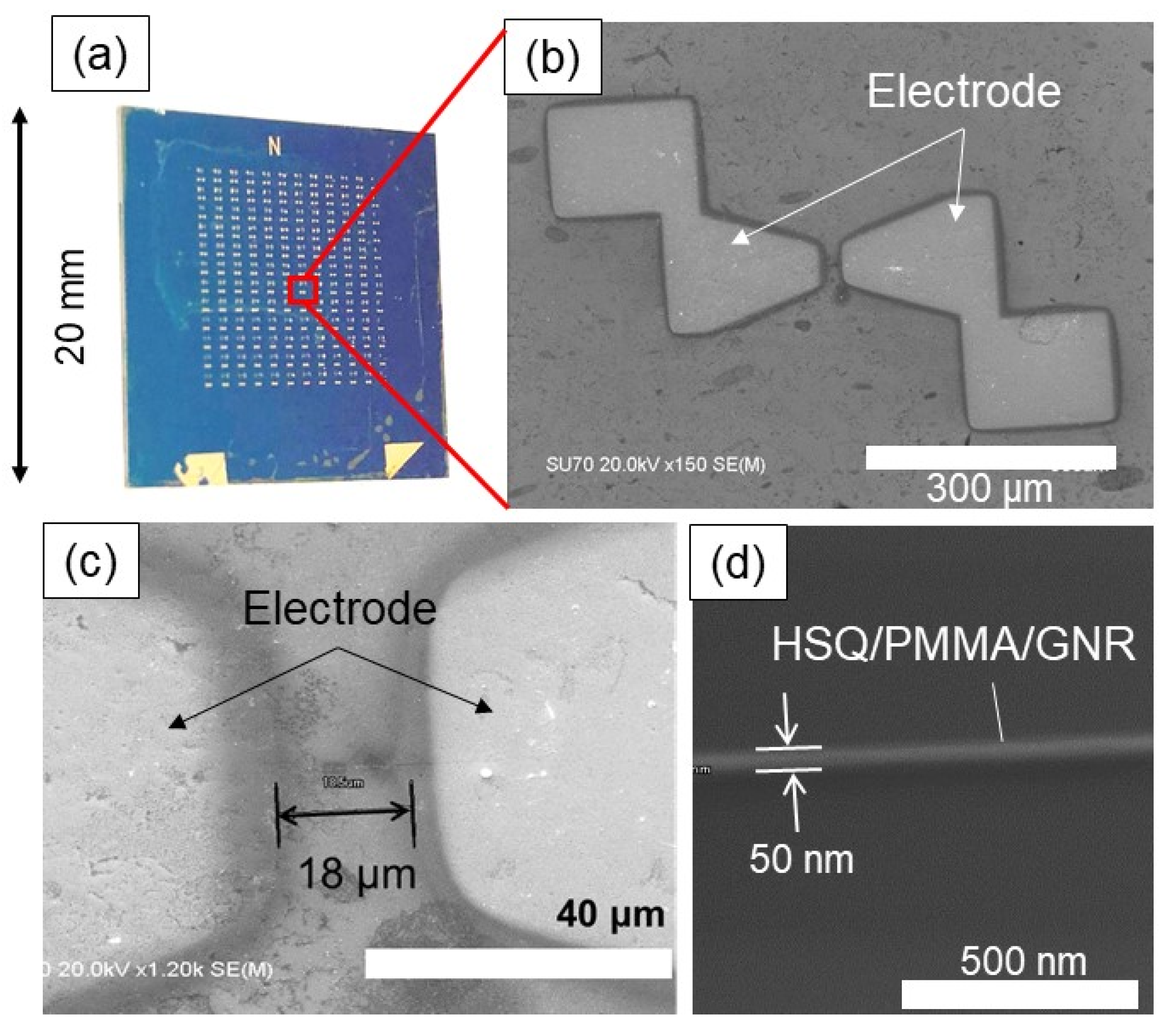
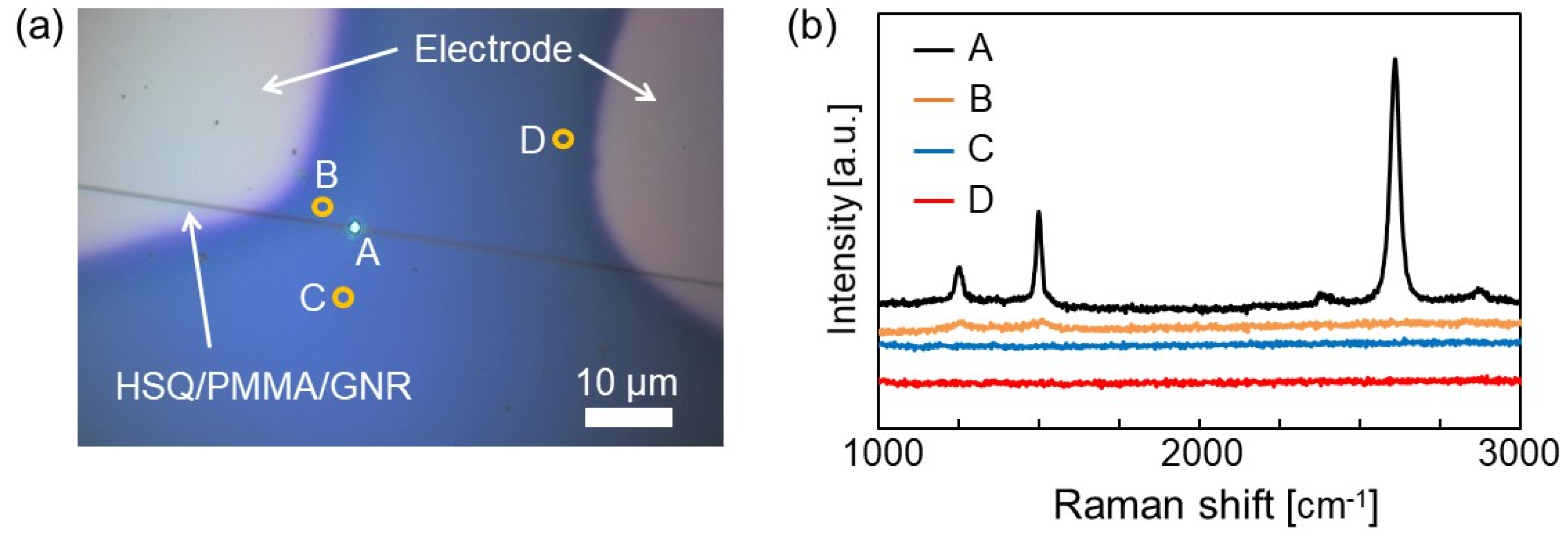
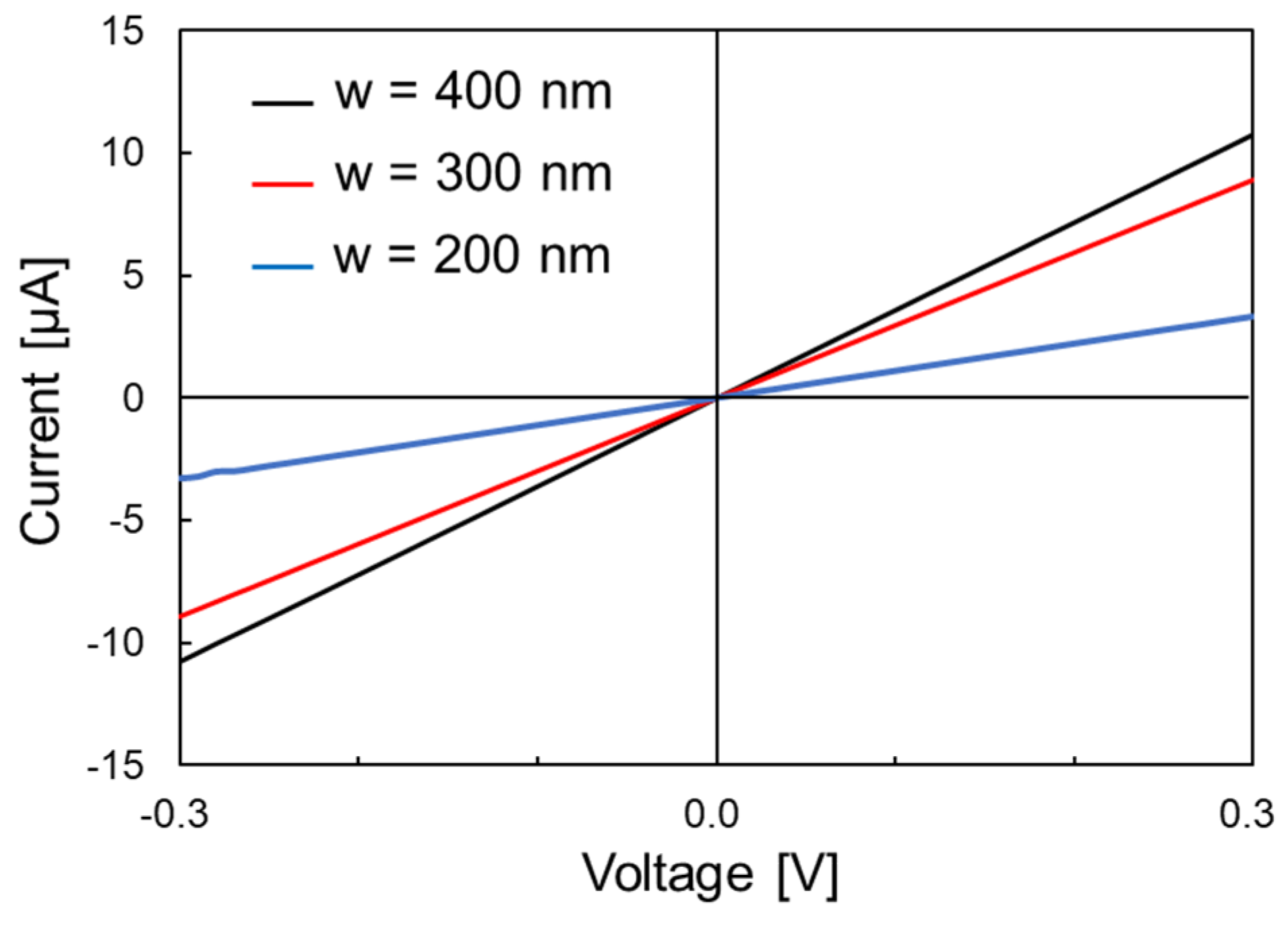
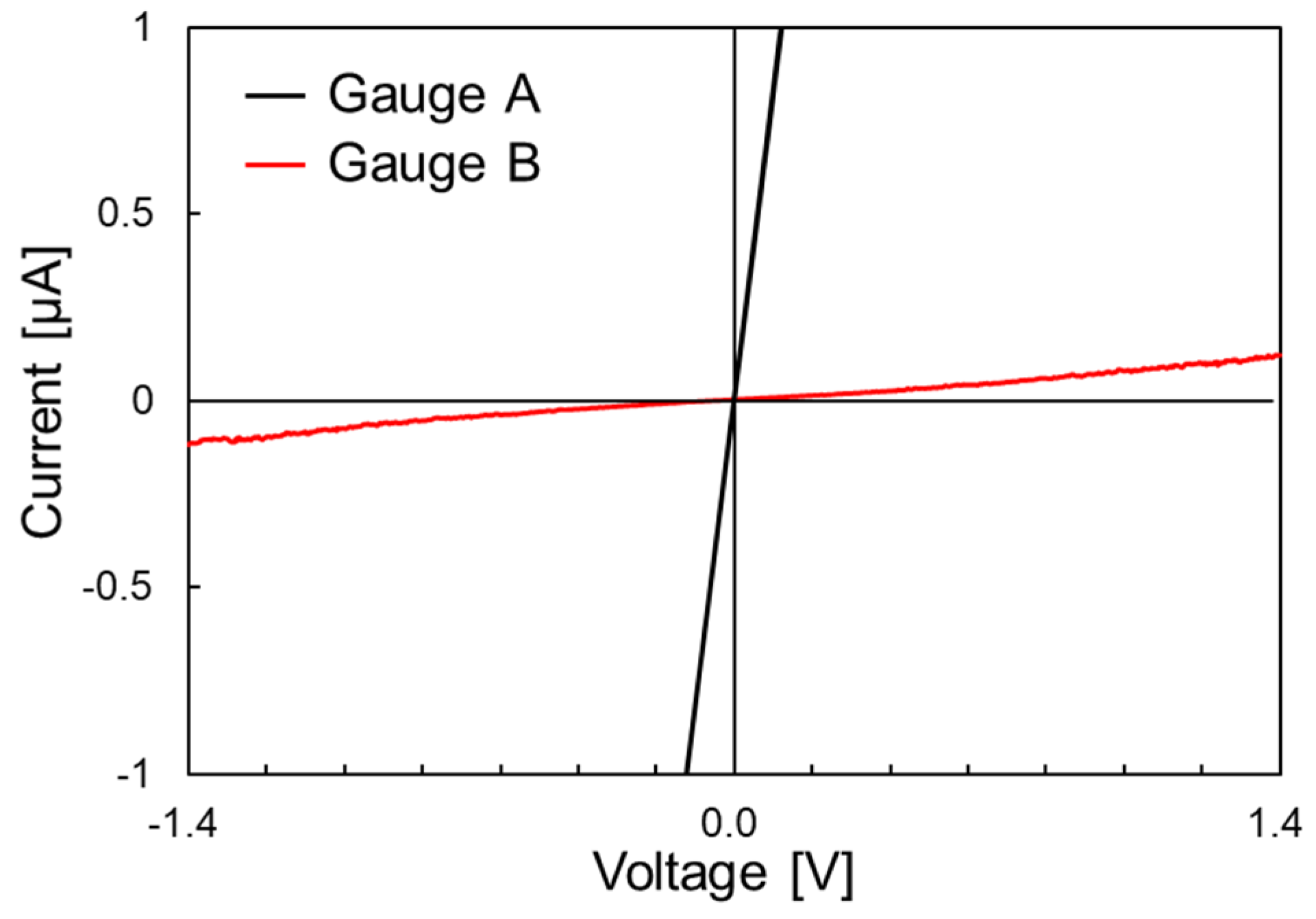
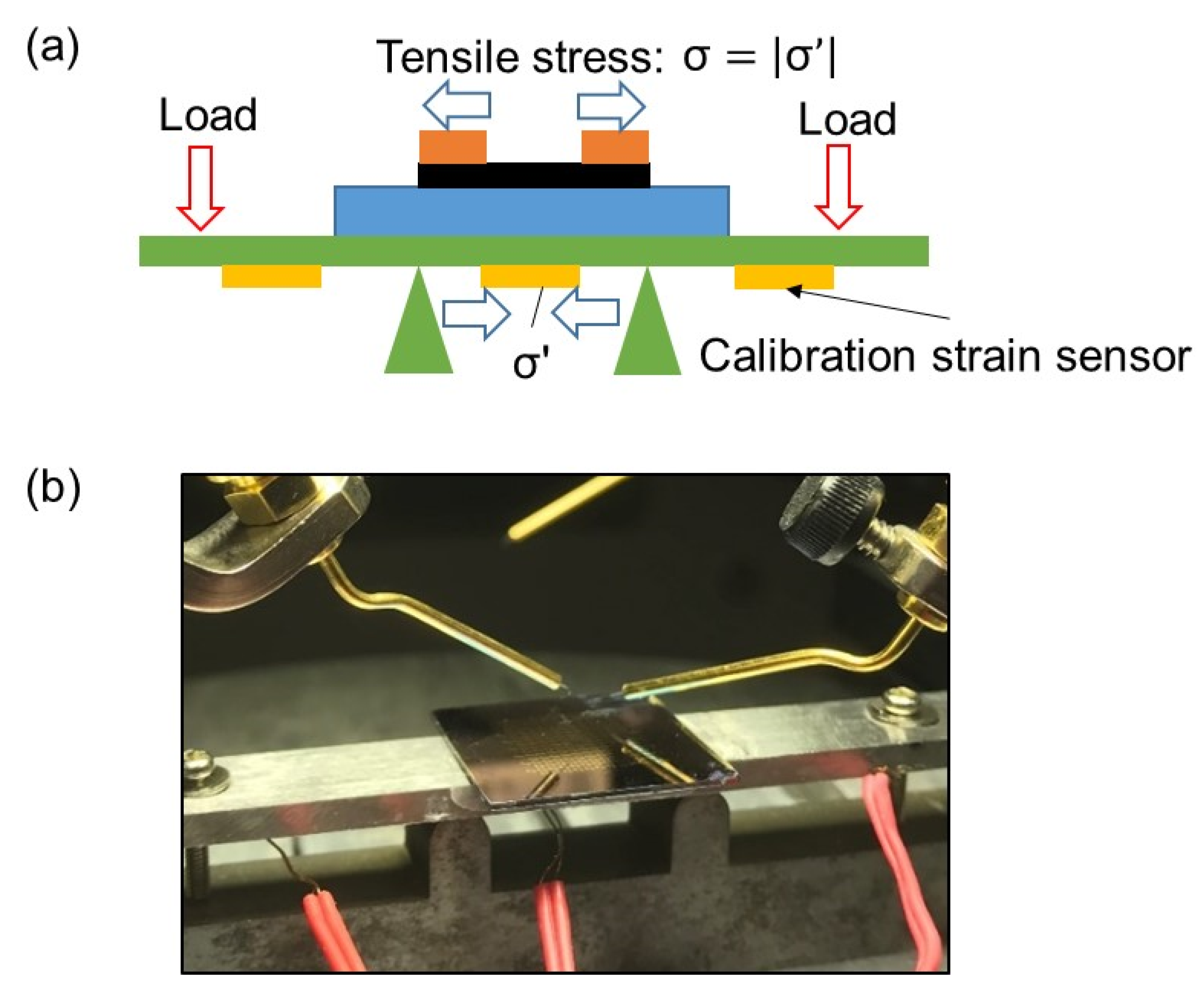
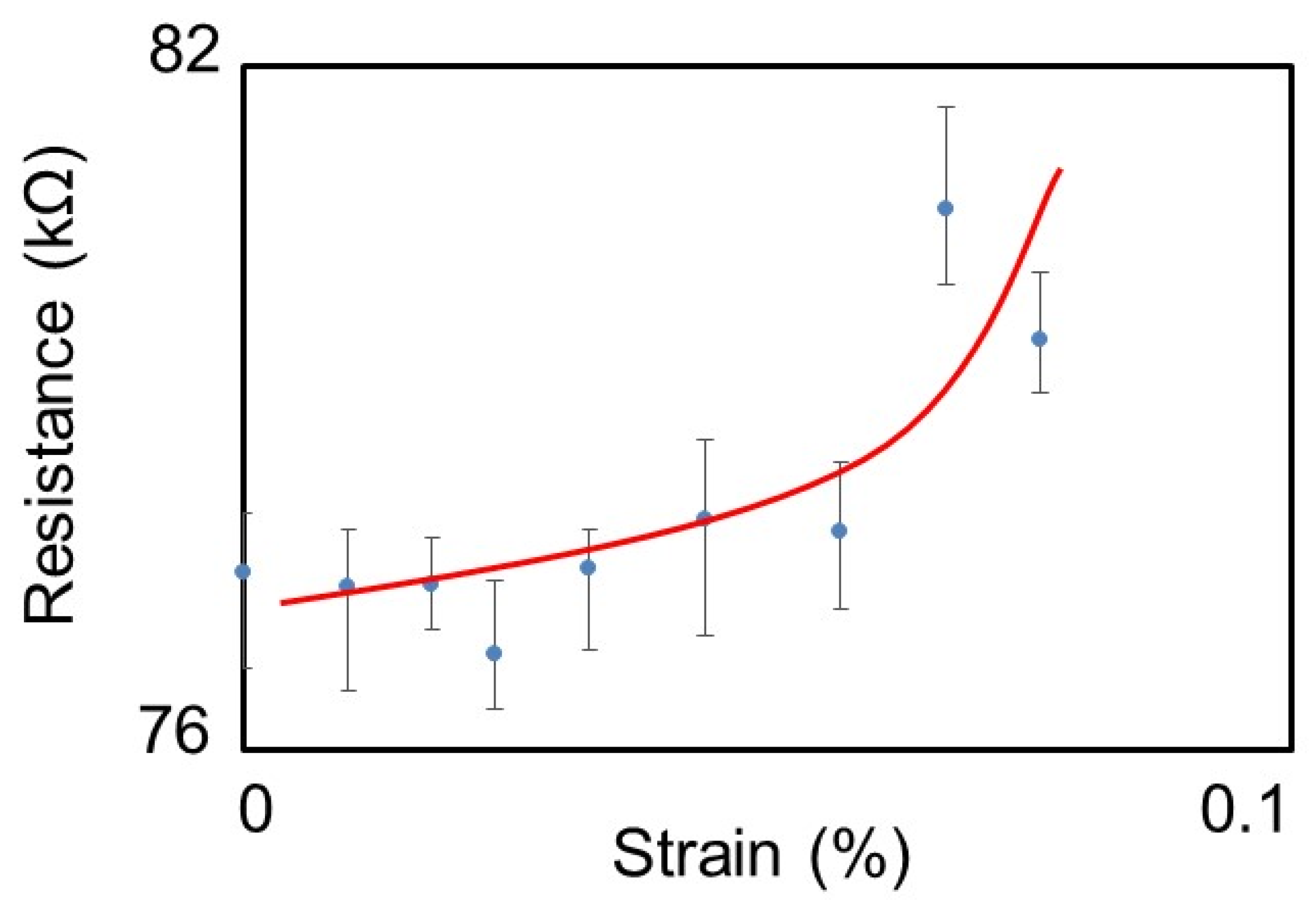
Publisher’s Note: MDPI stays neutral with regard to jurisdictional claims in published maps and institutional affiliations. |
© 2021 by the authors. Licensee MDPI, Basel, Switzerland. This article is an open access article distributed under the terms and conditions of the Creative Commons Attribution (CC BY) license (https://creativecommons.org/licenses/by/4.0/).
Share and Cite
Suzuki, K.; Nakagawa, R.; Zhang, Q.; Miura, H. Development of Highly Sensitive Strain Sensor Using Area-Arrayed Graphene Nanoribbons. Nanomaterials 2021, 11, 1701. https://doi.org/10.3390/nano11071701
Suzuki K, Nakagawa R, Zhang Q, Miura H. Development of Highly Sensitive Strain Sensor Using Area-Arrayed Graphene Nanoribbons. Nanomaterials. 2021; 11(7):1701. https://doi.org/10.3390/nano11071701
Chicago/Turabian StyleSuzuki, Ken, Ryohei Nakagawa, Qinqiang Zhang, and Hideo Miura. 2021. "Development of Highly Sensitive Strain Sensor Using Area-Arrayed Graphene Nanoribbons" Nanomaterials 11, no. 7: 1701. https://doi.org/10.3390/nano11071701
APA StyleSuzuki, K., Nakagawa, R., Zhang, Q., & Miura, H. (2021). Development of Highly Sensitive Strain Sensor Using Area-Arrayed Graphene Nanoribbons. Nanomaterials, 11(7), 1701. https://doi.org/10.3390/nano11071701




